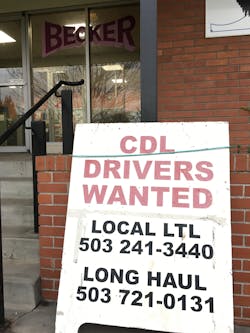Mark Allen, president and CEO of the International Foodservice Distributors Association (IFDA), said he has worked several years trying to convince members of Congress to assist in growing the pool of available truck drivers.
Allen said he reminds them that most states allow people as young as 18 to drive hundreds of miles within a single state, but are prevented from crossing a state line, even if located just a few miles away.
“They understand the absurdity,” he said.
The work by Allen and others including American Trucking Associations resulted in the introduction of the DRIVE-Safe Act, creating a path for those between the ages of 18-21 to get involved in interstate trucking.
The legislation creates “a level of safety and training that doesn’t exist today,” Allen told Fleet Owner by phone from Dallas, where IFDA was holdings meetings. “It provides an environment to train younger drivers with the right temperament and level of maturity to do the job in a safe and efficient manner.”
Allen said a young driver would be able to obtain a commercial license at any accredited school, and then receive the required 400 hours of on-duty time and 240 hours of driving time alongside an experience trucker from the hiring company.
The language of the bill says that an “experienced driver” is someone who is at least 21, has held a CDL for the past two years, has a minimum of one year operating in interstate commerce, and has no preventable accidents or pointed moving violations during the past year.
Allen said the drivers of his member companies generally need to handle some of the loading and unloading. As a result, many of these drivers “clock out” at a younger age than drivers in other sectors because they can’t physically do it anymore, he said.
As the third largest state in terms of square miles, California offers intrastate truckers unique opportunities. That is one reason why Patterson High School recently launched one of the first high school truck driving program in the United States.
Dave Dein, the program coordinator and instructor at the school located not far from Interstate 5, told Fleet Owner the legislation could be a “great opportunity” to attract more young people to the industry. He said his experiences with this new program has him convinced there are many young people with the maturity to learn how to be “professional” drivers.
Dein added that many fleets do not hire drivers that are 21 due to insurance concerns, and creating a mentoring program through this legislation could help ease this hurdle.
The DRIVE-Safe Act was introduced by Reps. Duncan Hunter (R-CA) and Trey Hollingsworth (R-IN).
“Unfortunately, we see many young Americans faced with the choice of either taking on thousands of dollars in college debt or entering into a job market with grim prospects for untrained workers,” said Hunter. The legislation “is a common-sense approach that creates job opportunities for younger workers and provides a vital resource to America’s trucking industry that is critical in supporting our growing domestic economy.”
“We feel pretty good we can build a lot of support for the legislation in a pretty quick fashion – and hopefully in a bipartisan way,” said Allen.
About the Author
Neil Abt
Neil Abt is a former FleetOwner editor who wrote for the publication from 2017 to 2020. He was editorial director from 2018 to 2020.

